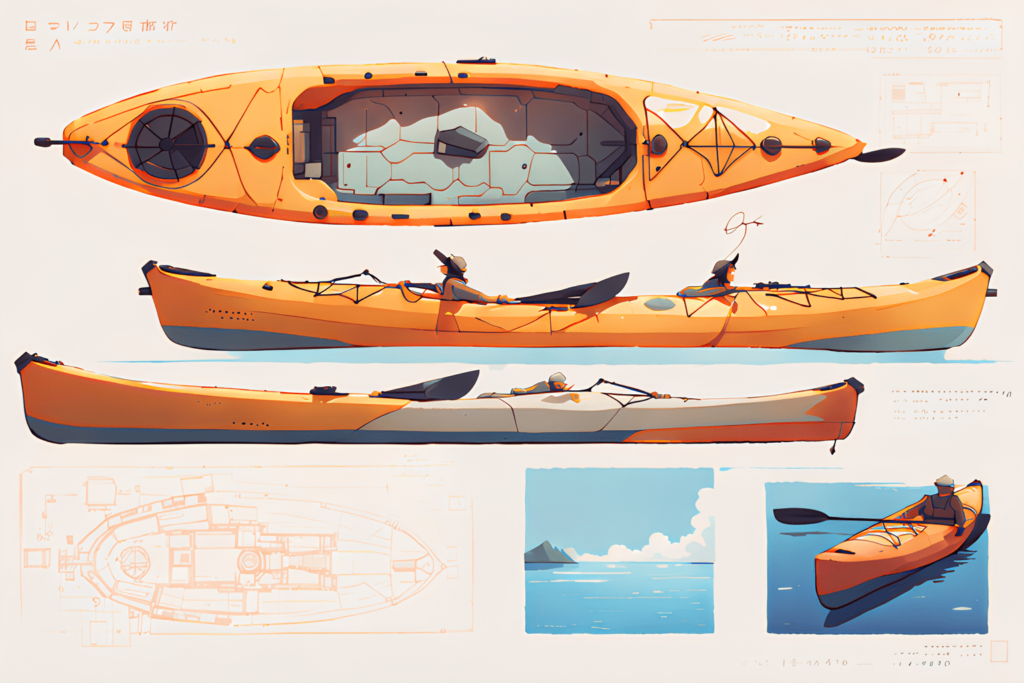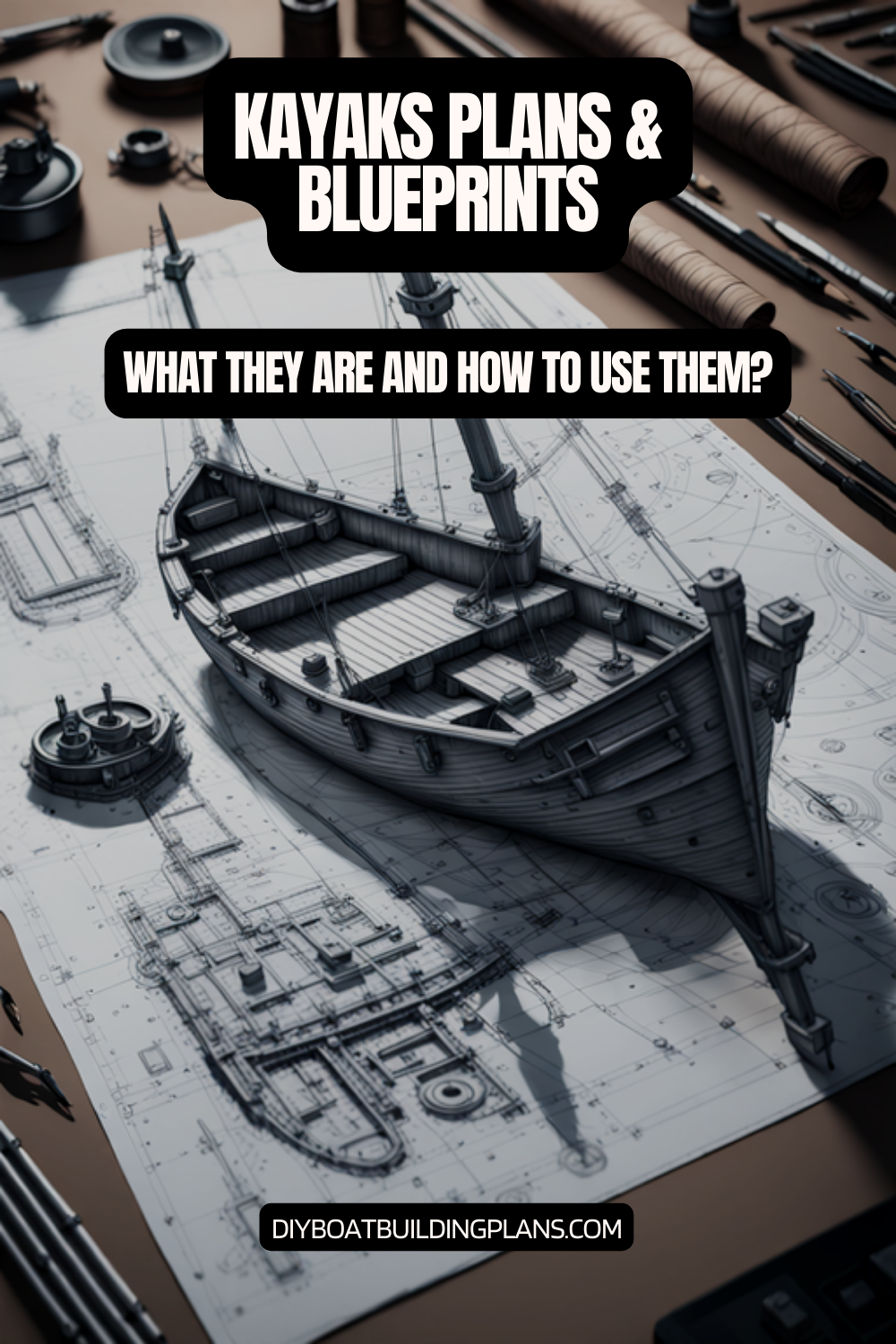Ever thought about turning a bunch of materials into a sleek kayak? Building your own kayak is more than a project—it’s an exciting journey.
DIY kayak plans let you create a kayak that fits your needs perfectly. Experts like Nick Schade from Guillemot Kayaks have been helping builders with top-notch designs for over 25 years. They make sure you get the best plans for building a kayak without breaking the bank.
Choosing professional kayak plans is more than saving money. It’s about making a kayak that shows your passion and skill. Designers spend years perfecting their designs to ensure they perform well and last long.
Key Takeaways – Kayak Plans & Blueprints
- Professional kayak plans offer precise blueprints for DIY enthusiasts
- Building your own kayak provides a personalized watercraft experience
- Quality plans help avoid costly mistakes in construction
- Experienced designers like Guillemot Kayaks provide reliable blueprints
- DIY kayak building combines craftsmanship with outdoor adventure

Introduction to DIY Kayaking
Starting DIY boating projects can turn your love for water into a fulfilling journey. Building your kayak brings creativity, personal joy, and saves money.
Kayak building is more than just making a boat. It’s about making a personal connection with your kayak. You learn about the details of boat design.
Benefits of Building Your Own Kayak
- Significant cost savings compared to purchasing commercial kayaks
- Complete customization of design and features
- Develop valuable woodworking and boat-building skills
- Personal sense of accomplishment
- Unique watercraft tailored to your specific needs
“The joy of kayaking is amplified when you’ve built the boat with your own hands.”
Overview of Materials Needed
To begin your DIY kayaking journey, you’ll need the right materials. The right supplies can make your kayak stand out.
| Material Category | Specific Items | Estimated Cost |
|---|---|---|
| Primary Structural Materials | XPS Foam Sheets | $50-$75 |
| Adhesives | Gorilla Glue (18oz bottle) | $15-$20 |
| Fabric | Canvas or Bed Sheets | $10-$15 |
| Additional Supplies | Bamboo Skewers, Wood Glue, Paint | $25-$40 |
Pro tip: The Sawfish kayak design is great for beginners. It uses materials from local stores and discount shops.
Types of Kayaks You Can Build
Starting a DIY kayak project opens a world of fun for water lovers. Whether you’re new or experienced, knowing the kayak types you can build is key. It helps you pick the right project for your skills and needs.
Building a kayak involves different techniques and designs. Wooden kayak patterns and fiberglass kayak plans let you create your dream watercraft. Let’s look at the most popular kayak types you can make in your workshop.
Sit-On-Top Kayaks
Sit-on-top kayaks are great for beginners and casual paddlers. They have many benefits:
- Easy to get in and out of
- Self-draining design
- Stable and easy to use
- Perfect for fishing and paddling in warm weather
Wooden kayak patterns for sit-on-top designs are usually 13 to 16 feet long and 22 to 30 inches wide.
Inflatable Kayaks
Inflatable kayaks are a unique challenge for DIY fans. They are lightweight, portable, and easy to store. Building them is more complex, but they offer:
- Compact transport
- Lightweight design
- Versatility for various water conditions
Touring and Sea Kayaks
For serious paddlers, touring and sea kayaks are the ultimate DIY project. Fiberglass kayak plans for these models usually have:
- Lengths between 16 to 22 feet
- Widths of 20 to 24 inches
- Improved tracking and performance
- Great for long-distance paddling
“Building your own kayak is not just about creating a boat, but crafting an experience that connects you with the water.” – Kayak Building Enthuasiast
Each kayak type needs specific skills and techniques. The right wooden kayak patterns or fiberglass kayak plans will help you through the process. You’ll turn raw materials into a beautiful, functional watercraft.
Essential Tools for Kayak Construction
Starting a kayak construction project needs careful planning and the right tools. Building your own kayak is exciting and rewarding. Having the right equipment makes it even better.
Hand Tools for Precision
Every kayak build begins with a set of hand tools. These tools help you build with precision and care:
- Coping saws for detailed cuts
- Utility knives for fine trims
- Pliers for gripping and adjusting
- Measuring tape for exact sizes
- Rasp for smooth edges
Power Tools for Efficiency
Power tools make building a kayak faster and more precise:
- Power circular sanders
- Cordless drill
- Jigsaw for complex cuts
- Power hand plane for smooth surfaces
Safety Gear: Your Essential Protection
Safety is key during kayak construction. Protect yourself with these important items:
- Safety glasses to protect your eyes
- Dust mask for breathing safety
- Work gloves for hand safety
- Ear protection with power tools
“The right tools make the journey of kayak building not just easier, but safer and more enjoyable.” – Experienced Kayak Builder
Choosing quality tools is important for a smooth kayak build. Most builders find a basic set, costing $125 to $150, is enough.
Selecting the Right Blueprint
Choosing the perfect DIY Kayak Plans & Blueprints is key for your kayak-building journey. The right folding kayak templates can make your project fun and rewarding.
Finding the right kayak design is important. Think about your skill level, where you’ll paddle, and what you want to achieve. These factors help pick the best blueprint for you.
Understanding Kayak Specifications
When looking at DIY Kayak Plans & Blueprints, focus on important details:
- Kayak length (affects speed and tracking)
- Width (influences stability)
- Weight capacity
- Intended water type (sea, river, lake)
“The right blueprint is your roadmap to a successful kayak-building project.” – Experienced Kayak Builder
Finding the Best Plans Online
Many trusted sources offer great folding kayak templates:
- MyBoatPlans 518 Boat Plans (wide range)
- Guillemot Kayaks (expert designs)
- Bryan Hansel’s Siskiwit Bay Kayak Plans
Pro tip: Look at popular designs like the Siskiwit Bay Multi-Chined kayak. It’s 17 feet long and 1.757 feet wide, perfect for plywood.
Unlock the secrets to building your dream boat with MyBoatPlans! With detailed plans for over 518 boats and expert video tutorials, you’ll have everything you need to create your perfect vessel. Click here to begin your journey!
Step-by-Step Guide to Building Your Kayak
Making a homemade kayak needs precision, patience, and planning. You must pay close attention to details and follow a step-by-step guide. Whether you’re new to building or have experience, knowing the key steps is essential for a great kayak.
Preparing Your Workspace
Having the right workspace is key for building a kayak. Choose a clean, well-ventilated area with enough space. Your workspace should have:
- Sturdy workbench or flat surface
- Adequate lighting
- Protection for floors and surfaces
- Organized tool storage
Cutting the Materials
When cutting materials, precision is vital. For plywood panels, use these tips:
- Use large paper sheets to create accurate templates
- Mark dimensions with ‘x’s for precise cutting
- Ensure plywood grain runs along the kayak’s long axis
“Measure twice, cut once” – A critical rule in homemade kayak designs
| Material | Recommended Specifications |
|---|---|
| Hull Length | 15-18 feet |
| Strip Thickness | 1/2 inch |
| Cockpit Dimensions | 29″ long, 18″ wide |
Assembly Process
Assembling your kayak needs careful steps. For stitch-and-glue designs, follow these instructions:
- Drill 1/16″ holes along panel edges
- Use 3″ copper wires to connect panels
- Twist wires securely to hold panels
- Use CA glue to reinforce seams
Pro tip: Always test-fit components before final assembly to ensure a perfect fit.
Common Mistakes to Avoid
Building your own kayak is an exciting DIY project. But, it needs careful attention to detail. Novice builders often face challenges that can affect the quality and safety of their kayak.
Precision in Measurement Matters
Getting measurements wrong can really hurt your kayak’s performance. Kayak builders should focus on important dimensions:
- Cockpit positioning (14-16 inches behind the Center of Buoyancy)
- Width specifications (maximum 13.5 inches at critical stations)
- Deck height and flatness
Critical Safety Procedures
Ignoring safety can make building a kayak risky. Important safety steps include:
- Wear the right protective gear
- Make sure there’s good air flow when using epoxy
- Use tools like nail files and debonders for safety
“Precision and patience are the hallmarks of successful DIY boating projects.” – Experienced Kayak Builder
Material and Construction Tips
Pay close attention to details to avoid common mistakes. Some key tips are:
- Mix epoxy in small batches (1/2 to 3/4 inch)
- Trim excess fiberglass carefully
- Apply varnish to protect against UV damage
- Check for gaps in joints
Remember, every mistake is an opportunity to learn and improve your kayak-building skills!
Tips for Customizing Your Kayak
Building a DIY kayak is more than just putting it together. It’s about making it your own. With DIY Kayak Plans & Blueprints, you can add your own special touches. These can make your kayak both stylish and practical.
Download over 500 Boat Plans. Click on the link below.
-->Click Here<--
Adding Smart Storage Solutions
Adding storage can make your kayak trips better. Here are some easy and affordable ideas:
- Waterproof deck bags for easy-access gear
- Integrated hatches with watertight seals
- Removable cargo nets
- Custom-built compartments for specific equipment
Enhancing Comfort Features
Comfort is key to a great kayak. Here are some ways to make it more comfortable:
- Adjustable ergonomic footrests
- Padded, contoured seats
- Custom thigh braces
- Anti-slip deck treatments
Aesthetic and Functional Improvements
Today, people are getting creative with their kayaks. They’re using everything from marine-grade enamel paints to printed fiberglass designs. It’s all about making your kayak stand out.
“A truly personalized kayak reflects both the builder’s craftsmanship and individual spirit.”
| Customization Type | Cost Range | Difficulty Level |
|---|---|---|
| Basic Storage Modifications | $20-$50 | Easy |
| Advanced Comfort Upgrades | $50-$150 | Moderate |
| Professional Aesthetic Finishing | $100-$300 | Advanced |
Always keep your kayak’s strength and performance in mind when customizing. Be careful, measure well, and enjoy making your kayak truly yours.
Maintenance and Care for Your DIY Kayak
After you’ve put time and effort into your homemade kayak, it’s important to take care of it. Regular maintenance keeps your kayak in great shape and makes it last longer.
Essential Regular Inspection Practices
Keeping your handcrafted kayak safe means checking it often after each use. Pay close attention to these key areas:
- Check hull for cracks or damage
- Examine seams and joints
- Inspect hardware attachments
- Look for signs of wear or delamination
Cleaning Techniques for Your Kayak
When cleaning your kayak, the material matters. Wooden kayaks need extra care than those made of synthetic materials.
- Rinse thoroughly with fresh water
- Use mild soap for deep cleaning
- Dry completely before storing
- Apply protective coating annually
“A well-maintained kayak is a safe and reliable companion on water adventures.” – Experienced Kayak Builder
Storage Recommendations
Storing your kayak right is key to keeping it in good shape. Keep it in a cool, dry spot, away from sunlight to avoid damage.
By sticking to these care tips, your handcrafted kayak will stay in top condition for many paddling adventures.
Enjoying Your DIY Kayak
Congratulations on finishing your DIY boating project! Building a kayak is just the start of a thrilling water adventure. Your budget-friendly kayaking journey is about to begin, and the excitement of hitting the water will be unforgettable.
Best Practices for First-Time Paddling
Before you go on your first trip, keep these tips in mind:
- Start in calm, shallow waters
- Wear a properly fitted personal flotation device
- Practice basic paddling techniques near the shore
- Check local water regulations
“The first paddle stroke is the beginning of an incredible journey” – Kayaking Enthuasiast
Planning Your Kayaking Trips
Good trip planning makes the most of your DIY boating projects. Here are some strategies:
- Research local waterways suitable for your kayak type
- Check weather conditions before departing
- Pack essential safety gear
- Inform someone about your planned route
Tip: Join local kayaking groups to expand your skills and discover exciting routes for budget-friendly kayaking adventures!

Resources for DIY Kayak Builders
Starting a DIY kayak project means you need good resources. These can help you through the complex steps of making your own kayak. There are many ways to learn and grow in the world of kayak building.
Experts suggest some top books for learning how to build a kayak. Nick Schade’s “The Strip-Built Sea Kayak” is a great choice for learning about wooden kayak building. Online groups like WoodenBoat forums and Facebook groups are also great for getting help and advice.
Recommended Books and Guides
Choosing the right books can really help your kayak building project. Look for guides with detailed plans, step-by-step instructions, and clear pictures. One Ocean Kayak offers complete packages with forms, plates, and manuals with 170 color photos and CAD drawings.
Online Communities and Forums
Joining online kayak building groups can speed up your learning. Sites like Reddit’s kayak building subreddits, woodworking forums, and kayak construction websites are full of helpful information. These places are great for solving problems, getting tips, and sharing your own experiences.
FAQ – Kayak Plans & Blueprints
How difficult is it to build my own kayak?
Building a kayak can be easy or hard, depending on the design. The Sawfish is great for beginners, needing simple tools and materials. More complex designs, like strip-built sea kayaks, require more skill and precision.
Your success depends on following instructions well, having basic woodworking skills, and choosing a plan that fits your experience.
What materials do I need to build a DIY kayak?
You’ll need foam, Gorilla Glue, fabric, wood glue, paint, bamboo skewers, and bucket lids. The materials change based on the design. Wooden kayaks need different stuff than foam or inflatable ones.
Always check the blueprint for the exact materials you need.
How much does it cost to build a homemade kayak?
Costs vary from $200 to $1,000, based on design and materials. The Sawfish kayak is cheap, using materials from hardware stores. Wooden sea kayaks cost more but offer better quality and performance.
How long does it take to build a kayak?
Time needed varies from a weekend to months. Simple foam kayaks take 2-3 days. Wooden designs can take over 100 hours.
Time depends on your skill, design complexity, work time, and detail focus.
Do I need professional woodworking experience?
No, you don’t need to be a pro. Many plans are for beginners, with clear instructions. You’ll need basic tools like safety glasses and hand saws.
Online tutorials and forums can help you learn the needed skills.
What types of kayaks can I build myself?
You can build many types, like sit-on-top, inflatable, and touring kayaks. Each type has its own building method. Choose based on use, water, and your skill.
How do I choose the right kayak plan?
Think about your skill, use, and desired performance. Check the plan’s specs like length and weight capacity. Choose plans from experienced designers like Guillemot Kayaks.
Consider your paddling experience, storage, and the waters you’ll paddle on.
What safety precautions should I take?
Wear safety glasses and a dust mask. Work in well-ventilated areas with glues and resins. Use tools carefully and follow instructions well.
Don’t rush and understand each step. Always wear a life jacket when paddling.



